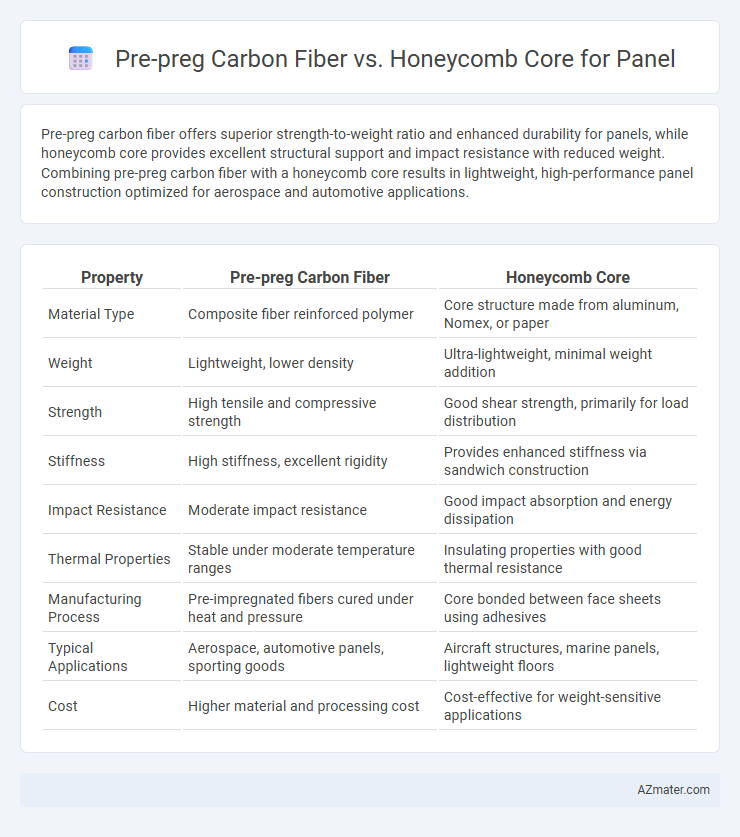Pre-preg carbon fiber offers superior strength-to-weight ratio and enhanced durability for panels, while honeycomb core provides excellent structural support and impact resistance with reduced weight. Combining pre-preg carbon fiber with a honeycomb core results in lightweight, high-performance panel construction optimized for aerospace and automotive applications.
Table of Comparison
| Property | Pre-preg Carbon Fiber | Honeycomb Core |
|---|---|---|
| Material Type | Composite fiber reinforced polymer | Core structure made from aluminum, Nomex, or paper |
| Weight | Lightweight, lower density | Ultra-lightweight, minimal weight addition |
| Strength | High tensile and compressive strength | Good shear strength, primarily for load distribution |
| Stiffness | High stiffness, excellent rigidity | Provides enhanced stiffness via sandwich construction |
| Impact Resistance | Moderate impact resistance | Good impact absorption and energy dissipation |
| Thermal Properties | Stable under moderate temperature ranges | Insulating properties with good thermal resistance |
| Manufacturing Process | Pre-impregnated fibers cured under heat and pressure | Core bonded between face sheets using adhesives |
| Typical Applications | Aerospace, automotive panels, sporting goods | Aircraft structures, marine panels, lightweight floors |
| Cost | Higher material and processing cost | Cost-effective for weight-sensitive applications |
Introduction to Composite Panel Materials
Pre-preg carbon fiber offers superior strength-to-weight ratio and excellent fatigue resistance for composite panel applications. Honeycomb core structures provide optimal stiffness and impact absorption while minimizing overall panel weight. Combining pre-preg carbon fiber skins with honeycomb cores creates advanced composite panels ideal for aerospace, automotive, and marine industries requiring high performance and durability.
What is Pre-preg Carbon Fiber?
Pre-preg carbon fiber consists of carbon fibers pre-impregnated with a controlled amount of resin, typically epoxy, ensuring consistent resin distribution and high fiber-to-resin ratio for superior strength and performance. This material offers excellent stiffness-to-weight ratio, enhanced mechanical properties, and improved durability compared to traditional laminate processes. Pre-preg carbon fiber is widely used in aerospace, automotive, and sporting goods industries where lightweight and high-strength panels are critical.
Understanding Honeycomb Core Structures
Honeycomb core structures consist of a lightweight, geometric matrix made from materials such as aluminum, Nomex, or thermoplastics, providing excellent stiffness-to-weight ratios in composite panels. These cores absorb stress efficiently and enhance impact resistance while maintaining structural integrity, making them ideal for aerospace, automotive, and marine applications. Pre-preg carbon fiber layered over honeycomb cores creates panels that optimize strength, durability, and weight savings critical for high-performance engineering solutions.
Strength and Weight Comparison
Pre-preg carbon fiber offers superior tensile strength and stiffness due to its precisely controlled resin content and fiber alignment, making it ideal for high-performance panels. Honeycomb core structures provide exceptional weight reduction by incorporating lightweight materials like aluminum or Nomex, while maintaining compressive strength through their geometric design. Combining pre-preg carbon fiber skins with honeycomb cores results in panels that optimize both strength-to-weight ratio and impact resistance for advanced aerospace and automotive applications.
Manufacturing Processes: Pre-preg vs Honeycomb
Pre-preg carbon fiber manufacturing involves layering resin-impregnated fibers with precise temperature and pressure curing, ensuring consistent fiber alignment and superior mechanical properties. Honeycomb core panels utilize a sandwich structure where lightweight honeycomb materials are bonded between face sheets, optimizing stiffness while reducing weight through adhesive bonding and curing techniques. The pre-preg process demands cleanroom environments and autoclave curing, whereas honeycomb core panels can be fabricated using vacuum bagging or resin infusion, impacting production speed and cost efficiency.
Mechanical Performance in Panels
Pre-preg carbon fiber panels offer superior tensile strength and stiffness due to their highly aligned fiber orientation and controlled resin content, making them ideal for high-performance structural applications. Honeycomb core panels provide exceptional compressive strength and impact resistance while significantly reducing weight, delivering excellent stiffness-to-weight ratios in aerospace and automotive components. Combining pre-preg carbon fiber skins with honeycomb cores maximizes mechanical performance by synergizing fiber strength with core resilience, optimizing panel rigidity and durability under various load conditions.
Cost Analysis: Pre-preg Carbon Fiber vs Honeycomb Core
Pre-preg carbon fiber panels generally incur higher initial manufacturing costs due to expensive raw materials and complex curing processes, but they offer superior strength-to-weight ratios and durability, potentially reducing lifecycle expenses. Honeycomb core panels, often made from materials like aluminum or Nomex, present a more cost-effective solution with lower material and fabrication costs, making them ideal for applications where budget constraints outweigh performance demands. Evaluating total cost of ownership requires balancing upfront investment in pre-preg carbon fiber against the economical production and maintenance advantages of honeycomb core structures.
Application Suitability in Various Industries
Pre-preg carbon fiber panels offer superior strength-to-weight ratios and excellent fatigue resistance, making them ideal for aerospace and high-performance automotive applications where precision and durability are critical. Honeycomb core panels provide exceptional impact absorption and structural rigidity while remaining lightweight, suited for marine, construction, and transportation industries requiring enhanced load distribution and energy dissipation. The choice between pre-preg carbon fiber and honeycomb core depends on specific industry demands such as stiffness, weight constraints, and environmental endurance.
Durability and Longevity Considerations
Pre-preg carbon fiber panels offer superior durability due to their tightly controlled resin content and uniform fiber alignment, resulting in excellent resistance to fatigue, impact, and environmental factors. Honeycomb core panels provide enhanced structural stiffness and lightweight benefits but may be more susceptible to core delamination and moisture intrusion over time, impacting longevity. Selecting between pre-preg carbon fiber and honeycomb core depends on the specific durability requirements and the operational environment of the panel application.
Choosing the Right Material for Your Panel
Pre-preg carbon fiber offers superior strength-to-weight ratio and excellent dimensional stability, making it ideal for high-performance panels requiring precision and durability. Honeycomb core materials provide exceptional stiffness and impact resistance while maintaining lightweight characteristics, suitable for larger panel structures where rigidity is critical. Selecting the right material depends on the application-specific requirements, balancing factors such as load-bearing capacity, weight constraints, and environmental exposure.

Infographic: Pre-preg Carbon Fiber vs Honeycomb Core for Panel
 azmater.com
azmater.com